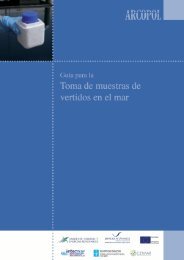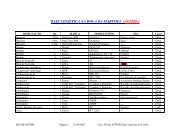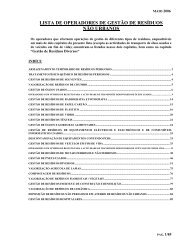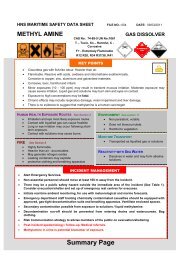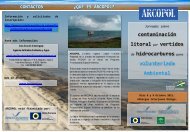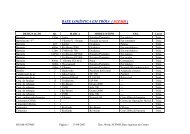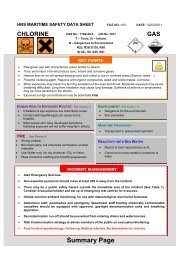ammonia gas (d) - Arcopol.eu
ammonia gas (d) - Arcopol.eu
ammonia gas (d) - Arcopol.eu
You also want an ePaper? Increase the reach of your titles
YUMPU automatically turns print PDFs into web optimized ePapers that Google loves.
HNS MARITIME SAFETY DATA SHEET FILE NO.: 001 DATE: 15/05/2010AMMONIAHUMAN HEALTH CONSIDERATIONS – See Section 3 to 6ERG 2008 Table 1: Initial isolation and protective action distancesGAS (GD)Chemical Name Spill Size DefinitionIsolation Zone in DownWind Protection Zoneall directions Day NightSmallFrom small package or smallleak form large package30m (100ft) 0.1 km (0.1mi) 0.2 km (0.1mi)AmmoniaLargeFrom a large package or2.3 km150m (500ft) 0.8 km (0.5mi)from many small packages(1.4 mi)FireIf substance involved in fire 1600 meters (1 consider evacuation for thatmile)distance in all directionsIsolation Distance: All personnel to be directed in a cross wind direction this distance from the spillProtective Action Zone: A square area down wind of the spill where protective action should be considered, starting with nearest receptors andworking away from spill.Such estimates should always be regarded with reservations and never be alternatives for monitoring.Acute Health Hazardsppm mg m -3 Signs and symptoms50 35 Slight irritation to eyes, nose and throat100 70 Rapid irritation to eye and respiratory tract700 488 Immediately irritating to eyes and throat1500 1045 Pulmonary oedema and coughing2500 1742 Life threateningMonitoring Strategy (Short & Long Term) & Equipment – See Section 6Health and SafetyEnvironmentalPublic HealthAir - Real-time electrochemical or photionisation detection or using quantitative colour change tubes(Draeger or similar). Water - Quantitative colour change kits or probes (Palintest or similar).Atmospheric fate and transport e.g. Aloha (immediate risk / first response), Calpuff (longer term)GP referrals, hospital admissions – numbers, symptomology, follow-up studies. (See Biomarkers)OPERATIONAL EMERGENCY RESPONSE – See Section 8 & 9Fire fightingmeasures:Decontamination ofrespondersResponse &Clean up:Waste ManagementUse fine spry to control mitigation of vapours. Use CO 2 or dry chemical extinguishers for small fires,water spray or foam for large fires. Tanks may explode when exposed to high temperturesDecontamination should be performed using local protocols in designated areas with adequateventilation. Water should be contained and disposed of at an appropriate waste facility.Protect sensitive water courses. Ammonia can enter drains when washed with water. Solutions may becontained and recovered.Ventilate confined spaces. Ammonia will not persist in the environment.Dispose as hazardous waste. N<strong>eu</strong>tralise strong solutions with dilute acid if necessary. Washcontaminanted clothing thoroughly before re-use.EMERGENCY CONTACTSORGANISATIONTELEPHONEFIRE, AMBULANCE, POLICE 999HEALTH PROTECTION AGENCY: Chemical Hazards Unit 08448 920555ENVIRONMENT AGENCY: 24/7 Pollution 0800 807060PAGE 2 OF 11Summary Page



